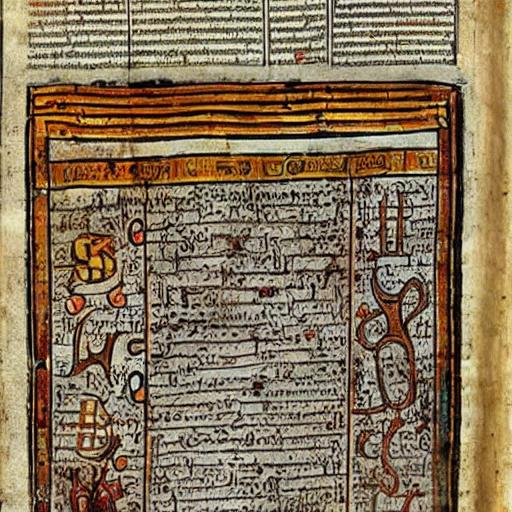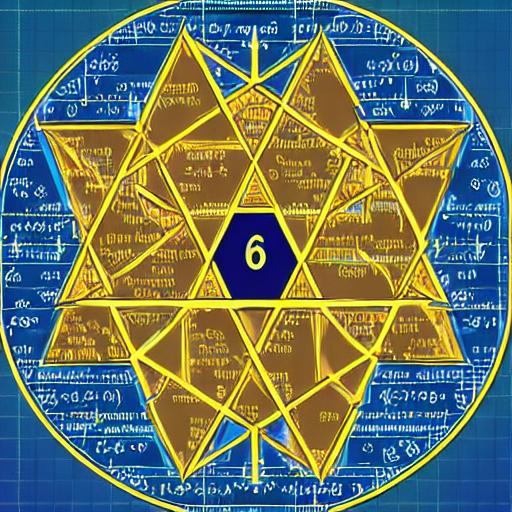Few numbers in history have inspired as much fascination, fear, and controversy as 666. Commonly known as "the number of the beast," this infamous numerical sequence has been the subject of religious speculation, cultural paranoia, and endless pop culture references. But what is the true origin and meaning of 666, and does it deserve its sinister reputation? Let's explore the history, interpretations, and gematria connections of this misunderstood number.

The Biblical Origins
The primary source for 666's notorious reputation comes from the Book of Revelation in the Christian New Testament. Specifically, Revelation 13:18 states: "This calls for wisdom: let the one who has understanding calculate the number of the beast, for it is the number of a man, and his number is 666."
This cryptic passage appears in a highly symbolic apocalyptic text, written during a time when early Christians faced persecution under the Roman Empire. The author, traditionally identified as John of Patmos, was likely using coded language to communicate with his audience while avoiding explicit sedition against Roman authorities.
The Numerical Context
It's crucial to understand that in the ancient world, letters and numbers were often interchangeable. Hebrew, Greek, and Latin all used letters to represent numbers before the adoption of Arabic numerals. This practice, called isopsephy in Greek and gematria in Hebrew, allowed writers to encode names as numbers—a common practice in the ancient Mediterranean world.
The specific instruction to "calculate" the number suggests that the original readers were expected to decode 666 back into a name or phrase, using the alphanumeric systems of their time. This wasn't viewed as occult practice but rather as a form of word puzzle or coded political commentary.
Historical Interpretations
Over the centuries, scholars and religious commentators have offered various interpretations of who or what the "beast" represented by 666 might be:
Emperor Nero Theory
One of the most compelling and historically grounded interpretations is that 666 was a coded reference to Emperor Nero, who ruled Rome from 54-68 CE and violently persecuted Christians. When the Hebrew spelling of "Nero Caesar" (נרון קסר, Neron Kesar) is calculated using Hebrew gematria, the sum equals 666:
- Nun (נ) = 50
- Resh (ר) = 200
- Vav (ו) = 6
- Nun (ן) = 50
- Kuf (ק) = 100
- Samech (ס) = 60
- Resh (ר) = 200
- Total: 666
Supporting this theory is the fact that some early manuscripts of Revelation list the number as 616 rather than 666. Interestingly, if the calculation is done using the Latin spelling of "Nero Caesar" instead of the Hebrew spelling, the value becomes 616. This textual variant provides additional evidence that the "beast" was intended to represent Nero.
Roman Empire Theory
A broader interpretation suggests that 666 represented not just Nero specifically, but the Roman Empire as a whole. Under this view, the beast symbolized imperial power that demanded worship and persecuted those who refused to participate in the imperial cult. The number served as a coded way for early Christians to identify their oppressor without explicitly naming Rome, which would have been dangerous.
Symbolism of Imperfection
Some theological interpretations focus on the symbolic meaning of 666 as a triple repetition of the number 6, which falls short of the perfect number 7 in biblical numerology. In this view, 666 represents the ultimate imperfection or incompleteness—human striving that repeatedly falls short of divine perfection. This interpretation sees the number as symbolic rather than as a code for a specific person or entity.
Gematria Insights on 666
Using various gematria systems, we can gain additional perspectives on the number 666:
Hebrew Gematria
In Hebrew gematria, besides the Nero calculation, there are other interesting connections. The Hebrew phrase "Seshach" (ששך), which appears in Jeremiah as a code name for Babylon (another empire that oppressed the Jewish people), has a gematria value of 620. Adding the numerical values of the letters in the Hebrew word for "Caesar" (קסר = 46) gives 666. This reinforces the connection between 666 and imperial power.
Additionally, the Hebrew phrase "Shem Yehoshuan" (שם יהשוען), meaning "The Name of Jesus," has a gematria value of 666 using a particular counting method. Some scholars see this as indicating that the early church saw a contrast between the true Messiah (Jesus) and the false messiah (represented by imperial power).
Greek Gematria
In Greek isopsephy (the Greek equivalent of gematria), the phrase "Lateinos" (meaning "Latin" or "Roman") calculates to 666:
- Lambda (Λ) = 30
- Alpha (Α) = 1
- Tau (Τ) = 300
- Epsilon (Ε) = 5
- Iota (Ι) = 10
- Nu (Ν) = 50
- Omicron (Ο) = 70
- Sigma (Σ) = 200
- Total: 666
This calculation, noted by early church fathers including Irenaeus in the 2nd century CE, reinforced the interpretation that the beast represented Roman power. It's one of the earliest documented attempts to decode the number.
English Gematria
In modern English gematria systems, numerous words and phrases have been manipulated to equal 666, often in an attempt to identify contemporary figures or institutions as the "beast." These calculations typically require selective methodology and often reveal more about the calculator's biases than about any inherent meaning in the number itself.
For example, using various selective counting methods, people have calculated "values" of 666 for figures ranging from various Popes to political leaders to corporations. Such calculations typically require arbitrary adjustments to make the numbers work, highlighting the risk of confirmation bias in numerical interpretation.
Cultural Impact and Misunderstandings
Regardless of its original meaning, 666 has taken on a life of its own in popular culture:
Hexakosioihexekontahexaphobia
Some people develop a specific fear of the number 666, a condition known as hexakosioihexekontahexaphobia. This fear has real-world consequences, with some individuals going to great lengths to avoid encountering the number in daily life—changing addresses, phone numbers, or even refusing to accept receipts totaling $6.66.
Cultural Avoidance
The stigma around 666 has led to its avoidance in various contexts. Some buildings skip from floor 665 to floor 667. Certain highways have changed their route numbers from 666. The original Route 666 in the United States was renamed to Route 491 in 2003 after years of complaints about the "evil" connotations and the frequent theft of route markers.
Pop Culture Embraces the Beast
In contrast to religious fear, pop culture has often embraced and played with the number's ominous reputation. From Iron Maiden's "The Number of the Beast" to references in countless horror films, 666 has become shorthand for anything with demonic or dark associations. This pop cultural usage often bears little resemblance to the number's historical context or original meaning.
Some artists and musicians have deliberately incorporated 666 into their work as a form of rebellion against religious orthodoxy or simply to generate controversy and attention. This appropriation has further cemented the number's place in cultural consciousness, though often divorced from its scriptural origins.
Scientific and Mathematical Perspectives
Beyond religious and cultural interpretations, 666 has some interesting mathematical properties:
Mathematical Curiosities
666 is the sum of the first 36 natural numbers (1 + 2 + 3 + ... + 36 = 666), making it a triangular number. It's also the sum of the squares of the first seven prime numbers (2² + 3² + 5² + 7² + 11² + 13² + 17² = 666).
The number is a double triangular number (666 = 6 × 111) and exhibits interesting patterns in its digits: 6 + 6 + 6 = 18, and 1 + 8 = 9, making 9 the digital root of 666. In the binary system, 666 is represented as 1010011010, which has a pleasing symmetry.
Coincidental Occurrences
Scientists note that many claimed "occurrences" of 666 in the world are simply the result of coincidence and confirmation bias. Humans are pattern-seeking creatures, and when we're primed to look for a specific number, we'll find it—just as we would find any other number if we were actively searching for it.
Theological Reconsiderations
Many contemporary theologians and biblical scholars take a more nuanced view of 666:
Contextual Understanding
Modern biblical scholarship emphasizes understanding Revelation in its historical context as a document written to encourage persecuted Christians, rather than as a predictive text about the distant future. From this perspective, 666 served as a coded reference that would have been meaningful to its original audience, not as a mysterious cipher for identifying future figures.
Symbolic Interpretation
Many theologians today interpret 666 symbolically as representing human systems and structures that set themselves against divine purposes. Under this view, the "beast" isn't a specific person but rather represents human institutions that demand ultimate allegiance and persecute those who refuse to comply.

Conclusion: More Symbolic Than Sinister
When we examine 666 through historical, cultural, and gematria lenses, we find a number that is more complex and nuanced than its popular reputation suggests. Rather than being inherently evil, 666 was most likely a coded reference used by an oppressed religious community to identify their persecutor without risking further danger.
The transformation of 666 from a political cipher into a universally recognized symbol of evil represents one of history's most successful cases of symbolic meaning-making. A number that likely began as a coded reference to Emperor Nero or the Roman Empire has evolved into a potent cultural symbol that continues to evoke strong reactions more than 1,900 years after it was written.
Understanding the gematria behind 666 helps us appreciate the sophisticated wordplay and numerical encoding that ancient writers employed. Far from being primitive superstition, the use of numerical symbolism represented an advanced form of literary and political communication in its time.
Perhaps the most important takeaway from our exploration of 666 is that numbers themselves are neither good nor evil—they acquire meaning through cultural and religious contexts. The next time you encounter 666, rather than reacting with fear, you might appreciate it as a fascinating window into ancient communication techniques and the human tendency to find meaning in numerical patterns.
